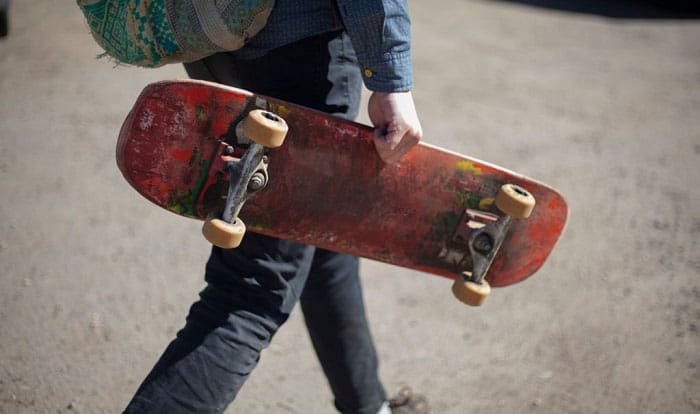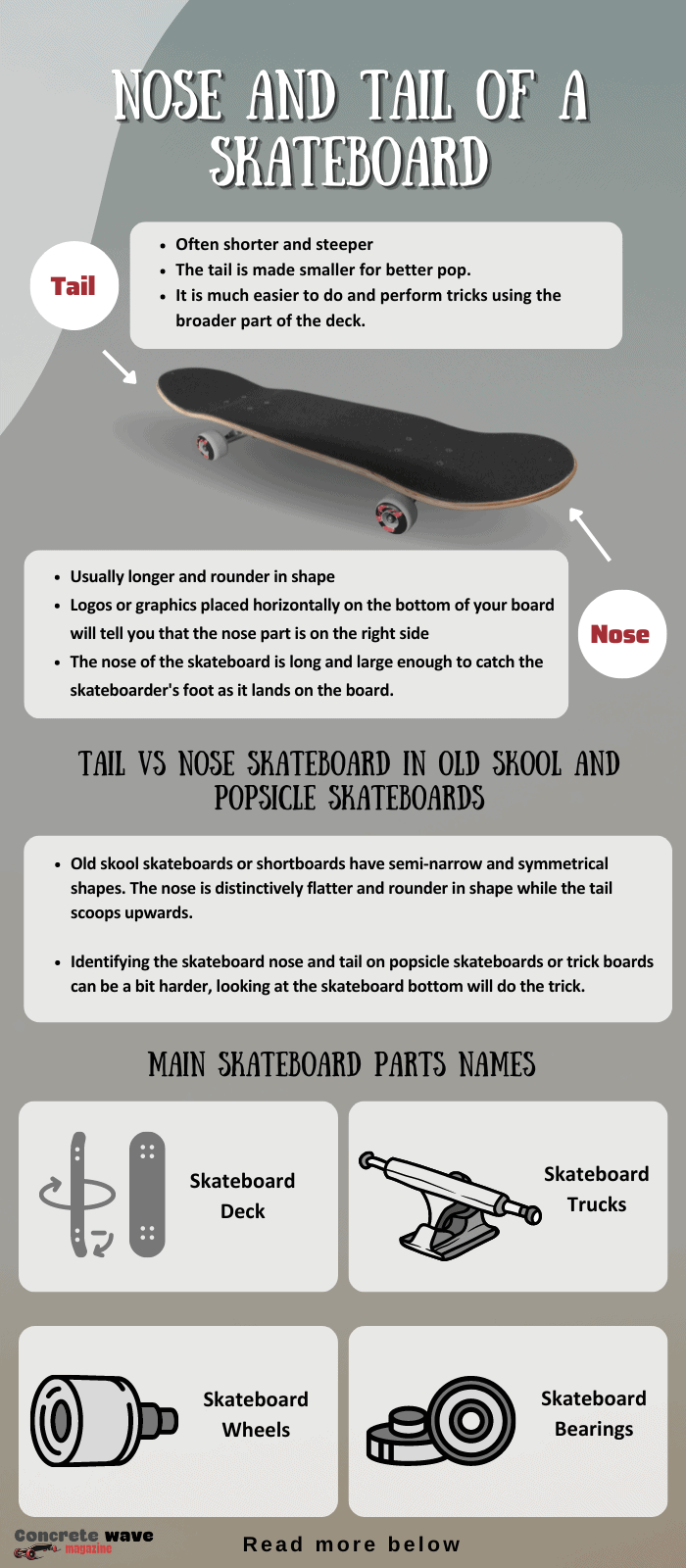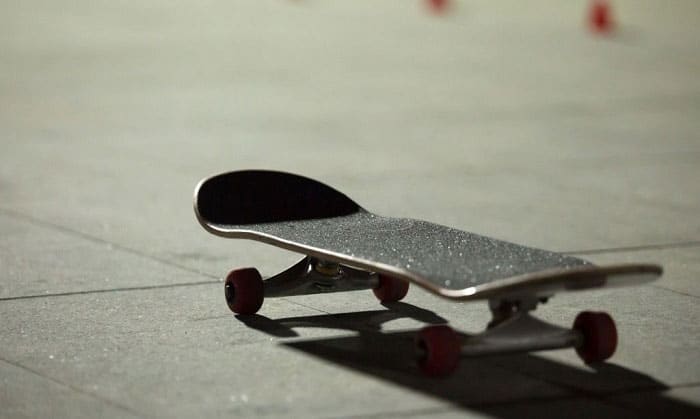How to differentiate the nose and tail of a skateboard? The front and back of a skateboard are pretty similar, making it tricky for us to tell them apart. But the truth is they have minimal differences that skateboarders must know.
The front of a skateboard is called the nose, while the rear part is known as the tail.
Table of Contents
Which Side Is the Tail on a Skateboard?
And the tail is often shorter and steeper.
Which Side of a Skateboard Is the Nose?
If you look closely, the nose is usually longer and rounder in shape.
Also, the graphics placed by the manufacturers under your skateboard can allow you to determine which side is the nose or the tail. The placement of these logos and graphics will help you to differentiate these two parts easily.
Logos or graphics placed horizontally on the bottom of your board will tell you that the nose part is on the right side, while the vertical logos and graphics will tell you that the nose is on the upper part of the board.
Tail Vs Nose Skateboard in Old Skool and Popsicle Skateboards
Let’s look at the difference of these parts in the comparison between these two shapes of skateboards – the old skool skateboards and popsicle skateboards.
- Old skool skateboards or shortboards have semi-narrow and symmetrical shapes. In this board shape, you can easily spot the difference between the nose and the tail. The nose is distinctively flatter and rounder in shape while the tail scoops upwards.
- Identifying the skateboard nose and tail on popsicle skateboards or trick boards can be a bit harder. They have unnoticeable differences that thorough inspection needs to be done. In some cases like this, looking at the skateboard bottom will do the trick.
Why Is the Skateboard Nose Longer and Larger?
The reason is simply that this part of the deck should be made longer and broader enough to catch the skateboarder’s foot as it lands on the board.
Why Is the Skateboard Tail Smaller?
The tail is made smaller for better pop. It is easier to skate and respond when you use the smaller part of the board rather than the larger end.
On the other hand, it is much easier to do and perform tricks using the broader part of the deck.
Notes: Riding on the tail or the nose of the skateboards depends on the skater’s preference and style in skateboarding. You can skate using either part of the board. But your skateboard decks will wear down faster than expected if you use the nose as the tail and vice versa.
To protect and prolong the life of the nose and tail of your skateboard, use a skateboard tail guard and skateboard nose guard.
Main Skateboard Parts Names
Skateboard consists of different parts having functions crucial to the overall performance of the board. The tail and nose of a skateboard were just two of the important parts of a skateboard. Let us have a short discussion of these parts of the skateboard.
Skateboard Deck
The term used in identifying this part of the skateboard is the board. This is the wooden part of the skateboard where the trucks are attached.
A layer of wood placed in your skateboard is called ply. 7 to 9 plies of maple wood are usually used in many skateboards for its durability and strength. These plies of wood were glued to one another using laminates.
Furthermore, there is a grip tape on top of the board for better grip and secured footing. You can find the tail and the nose of a skateboard on this part.
Other parts of the deck include the mounting holes. A total of eight mounting holes are drilled to attach the skateboard wheels to the board.
Skateboard Trucks
- The axle is a metal rod attached to your wheels, and axle nuts are added to hold it in place. The two donut-shaped parts of the truck that are inserted into the kingpin are called bushings.
- Another part of the truck is called the baseplate. It consists of a plate with 4 or 6 mounting holes, pivot, and kingpin. And then there is the truck hanger. It is locked onto the kingpin and put in the baseplate’s pivot cup.
- A pivot truck, on the other hand, is a cup-shaped plastic in the baseplate. Its primary purpose is to support the truck hanger to give smooth turns.
- The kingpin supports the hanger and the bushings. The nut that holds the truck hanger and the bushings in their proper place is called the kingpin nut.
Skateboard Wheels
Your skateboard cannot run without the wheels. Skateboard wheels are made of durable materials called polyurethane. The hardness of skateboard wheels can be measured in a durometer.
The part of the wheels where you insert the bearing is called the core. The bearing seat is part of the wheel’s core, and its main function is to hold the bearings in a vertical position and keep the wheel centered on the inside.
Skateboard Bearings
Skateboard bearings are located inside your skateboard wheels. Two bearings were needed on each wheel of the skateboard. A total of eight bearings are required in a single skateboard setup.
Other parts of wheel bearings include the balls, the shield, the retainer, the inner and the outer race. Bearings usually consist of 6 to 8 balls placed inside.
Delrin crowns, commonly known as the retainer, are responsible for holding and separating the balls within the bearings. The bearing c-clip locks the bearing shield in its proper place.
Conclusion
How to tell the difference between the nose and tail of a skateboard? For a beginner nose and tail skateboard can be tricky to identify, but experienced skateboarders know how to spot their differences.
You can easily differentiate them from one another according to their shapes, size, length, and steepness. I hope this article provided you with the things you need to distinguish the skateboard tail from the nose. If you have other concerns, feel free to comment down below.

Hi, I am Charles Harris. I opened this site to write as much as I can about my biggest passion – skateboarding!
I started as a clumsy yet passionate rookie 10 years ago to now a still passionate yet much better skateboarder! But I have to tell you, the whole journey has always been fun and rewarding, indeed not without hardship.




